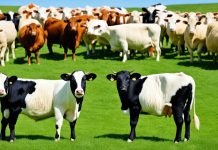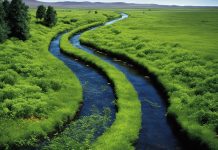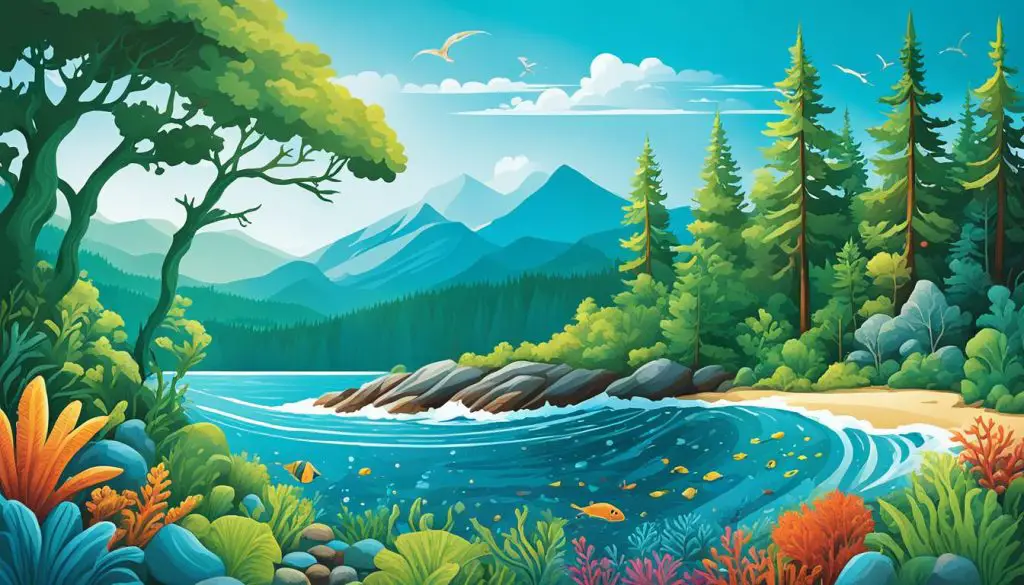
Planet Earth hosts an immense tapestry of life, a testament to ecosystem diversity that pervades every corner of the globe. From the lush depths of ancient rainforests to the enigmatic expanse of desert landscapes, our world comprises diverse ecosystem categories that sustain the complex web of life.
Diving into the myriad forms that nature takes can lead to pressing questions, such as “what are the types of biodiversity?” As we explore, we come to understand how each species and the singular genetic narrative it carries contributes significantly to an ecosystem’s resilience and productivity. We journey through the awe-inspiring variety of habitats that paint our planet’s ecological canvas.
One finds that every ecosystem is a universe in its own right. Rich with interconnected life forms and abiotic factors solidifying those connections, each ecosystem illustrates a unique chapter in Earth’s grand story of natural diversity. Let’s uncover the beautiful complexity of the ecosystems that nurture our existence.
Understanding Biodiversity: The Fabric of Life on Our Planet
The intricate tapestry of life on Earth, known as biodiversity, plays a pivotal role in maintaining the vitality and equilibrium of our planet’s ecosystems.
Biodiversity encapsulates the health of ecosystems, which in turn governs the air we breathe, the water we drink, and the food we consume. Let’s delve deeper into the expansive variety of life that inhabits different ecosystems, the ongoing quest for species discovery, and the precious hotspots of biodiversity that are vital to our planet’s resilience.
What Is Biodiversity?
Biodiversity represents the entire spectrum of life on Earth – every plant, animal, fungus, and microorganism, as well as the ecosystems they inhabit. The lush Amazon rainforest, the vast savannas of Africa, and the mesmeric coral reefs all serve as exemplary stages where the drama of life unfolds.
This diversity is not just a testament to the wonder of nature but also a fundamental pillar that supports the livelihoods and well-being of human populations everywhere.
Understanding Biodiversity and Its Elements
The concept of biodiversity encompasses three fundamental levels:
- genetic diversity,
- species diversity, and
- ecosystem diversity.
Genetic diversity represents the range of genetic characteristics within each species, providing populations with the ability to adapt to changing environments.
Species diversity refers to the multitude of living organisms that inhabit the major ecosystems of the world.
Ecosystem diversity captures the variety of ecological systems, each with unique processes and interactions that sustain life.
The Significance of Species Discovery
Imagine a world where every day could potentially bring forth the discovery of a new species. Indeed, that is our reality, as new species are uncovered regularly, enriching our understanding of biodiversity. Each discovery is akin to finding another piece in the puzzle of life, providing insights that can lead to breakthroughs in medicine, agriculture, and ecosystem conservation.
Hotspots of Biodiversity and Their Unique Inhabitants
Hotspots of biodiversity are truly remarkable regions where you can find a plethora of endemic species—nature’s exclusive designs, sequestered in the nooks and crannies of our planet, like Madagascar’s lemurs or Australia’s kangaroos. These endemic species remind us of the fragility and diversity of life, urging the need for thinking globally while acting locally to preserve our natural heritage.
| Biodiversity Hotspot | Location | Notable Endemic Species |
|---|---|---|
| Himalaya | Asia | Snow Leopard, Red Panda |
| California Floristic Province | North America | California Condor, Giant Sequoia |
| Cape Floristic Region | Africa | Protea, Geometric Tortoise |
| New Caledonia | South Pacific | Kagu, New Caledonian Owlet-nightjar |
As you explore these diverse ecosystems, remember that your role in understanding and preserving biodiversity is paramount. The myriad species that are yet to be discovered are not mere curiosities; they are critical players in the broad ecological networks that sustain our earth. It’s a mission of curiosity that brings with it the responsibility to protect these irreplaceable hotspots of biodiversity and their unique, endemic inhabitants.
The Consequences of Biodiversity Loss
Biodiversity loss is an alarming trend with far-reaching implications. With the extinction of each species and the degradation of natural habitats, we lose irreplaceable genetic material and weaken the very fabric of the ecosystems that support us. As a result, the critical services that biodiversity provides – such as water purification, pollination of crops, and the regulation of climate – are under threat, amplifying the urgent need to address the causes of biodiversity loss and protect our planet’s delicate ecological balance.
Drivers of Biodiversity Decline
The loss of biodiversity is driven by multiple, often intertwined causes. Prominent among them are drastic changes in land and sea use, which fragment and degrade the habitats that various species and ecological systems rely on.
The relentless exploitation of natural resources, accelerated by climate change, pollution, and the spread of invasive species, poses serious threats to ecosystems and their inhabitants. Understanding and mitigating these pressures is paramount to conserving the genetic diversity and richness of life that forms the backbone of our environment.
Types of Ecosystems
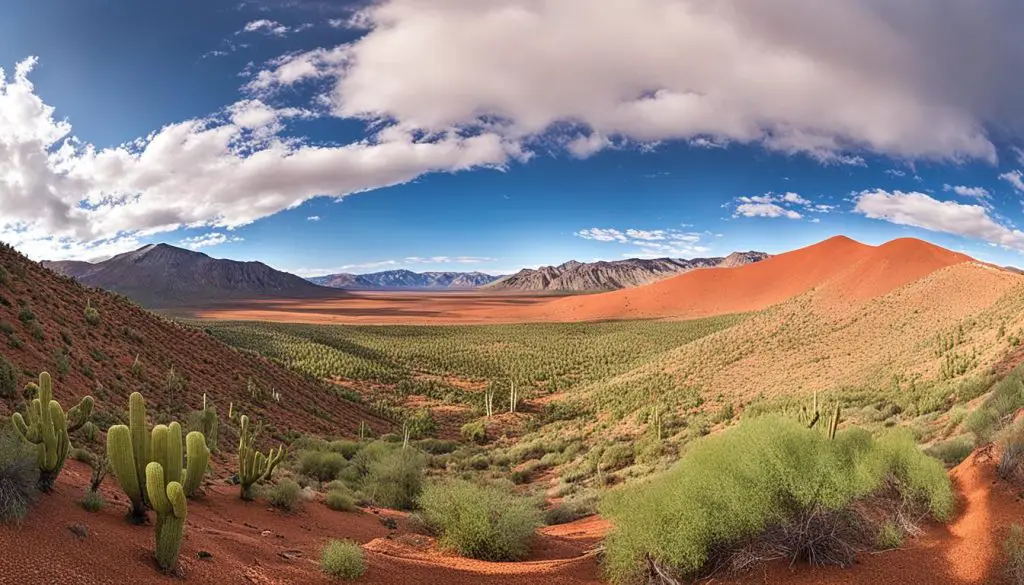
The variety and richness of life on Earth can be largely attributed to its diverse types of ecosystems. Ecosystems can be classified into two fundamental categories:
- terrestrial and
- aquatic.
Terrestrial ecosystems include habitats like forests and deserts, while aquatic ecosystems encompass both freshwater and marine environments.
Each type of ecosystem is characterized by unique physical factors – such as climate and soil type – that determine the kinds of life forms that can thrive within them.
Understanding the ecosystem classification and the examples within each category is crucial for recognizing the complexity of our planet’s biosphere. The following ecosystem types and examples provide a glimpse into the breadth of environments that support life:
- Forests: Expanses of tree coverage that range from the densely tree-packed rainforests near the equator to the coniferous forests of the colder, northern latitudes.
- Grasslands: Wide, open plains predominantly covered by grasses, often found between forest and desert ecosystems, which include the great savannas and prairies.
- Tundras: The coldest of all the ecosystems, largely devoid of trees, where the subsoil is permanently frozen and the vegetation is limited to low-growing shrubs and grasses.
- Deserts: Arid environments that receive very little rainfall and where specialized plants and animals have adapted to the harsh conditions.
- Freshwater Environments: Inland water bodies like rivers, lakes, and streams that house diverse species adapted to the water’s low salt concentration.
- Marine Ecosystems: Saltwater environments of the oceans, which include coral reefs, deep sea, and estuaries teeming with marine life.
Such diversity among ecosystems is indispensable to the stability and sustainability of our environment. The intricate interdependence within and between these ecosystems is a testament to the adaptability and resilience of living organisms. Below is a table categorizing the primary types of ecosystems and some of the unique characteristics that define them:
| Ecosystem Type | Defining Characteristics | Examples |
|---|---|---|
| Forest | Dense tree cover, rich biodiversity, crucial oxygen supply | Amazon Rainforest, Black Forest |
| Grassland | Grassy plains, fertile soils, significant carbon sink | Serengeti Plains, Great Plains |
| Tundra | Permafrost subsoil, low vegetation, cold-tolerant species | Arctic Tundra, Alpine Tundra |
| Desert | Low precipitation, extreme temperatures, adapted flora and fauna | Sahara Desert, Mojave Desert |
| Freshwater | Inland waters, diverse aquatic life, crucial for species’ life cycles | Mississippi River, Lake Baikal |
| Marine | Saltwater, high biodiversity, includes the deepest parts of the ocean | Great Barrier Reef, Marianas Trench |
By examining ecosystem types and their unique attributes, we gain insight into the remarkable adaptability and interconnectedness of life on Earth.
The Aquatic Ecosystems
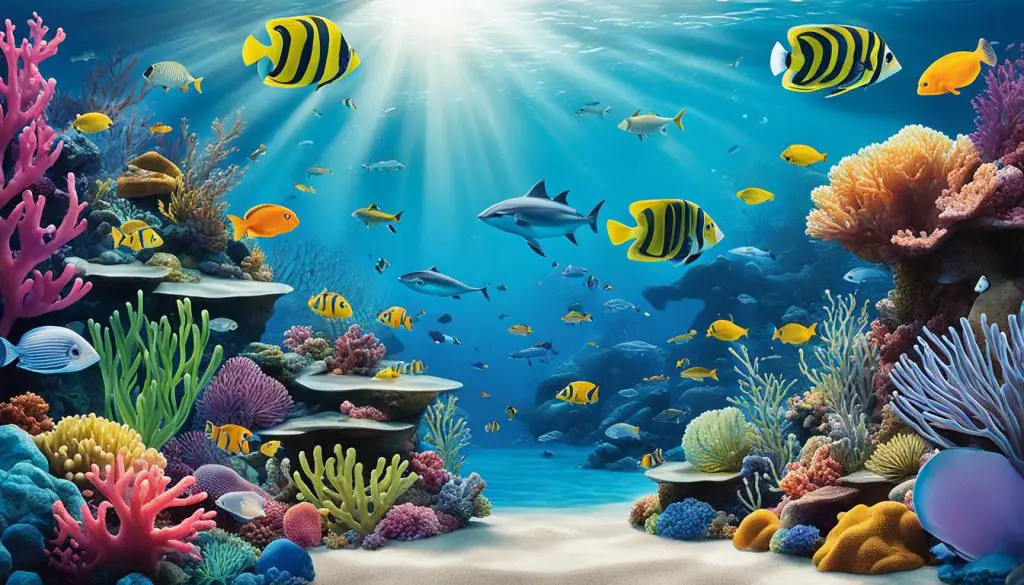
When you think of aquatic ecosystems, what comes to mind? Perhaps you imagine the vast, open ocean or the dynamic life within a bustling coral reef. Aquatic ecosystems are remarkable biomes, comprising both marine and freshwater habitats. They are crucial for supporting a diverse range of life forms, many of which depend on very specific conditions to thrive.
The significance of aquatic habitats extends beyond mere existence; they are foundational to sustaining a myriad of species and are central to the very essence of ocean biodiversity.
Marine Ecosystems: Oceans, Reefs, and Estuaries
The expanse of marine ecosystems is as impressive as it is important. From the sunlit upper layers of the oceans teeming with lively fish schools to mysterious deep-sea vents, marine habitats host an endless array of ecological activities.
These environments are more than just housing for creatures; they bestow upon us essential services like climate regulation and serve as fundamental resources for food and recreational activities.
The essence of ocean biodiversity cannot be overstated, as it is the lifeline of marine habitats and, by extension, our own survival.
- The open ocean, or pelagic zone, is the largest aquatic environment where you find species such as whales, sharks, and jellyfish.
- Reefs, particularly coral reefs, are vibrant ecosystems that harbor thousands of marine species and provide protection and food.
- Estuaries, the bridges between freshwater and marine ecosystems, serve as nurseries for many fish and marine invertebrates, adjusting to the mix of salt and fresh water.
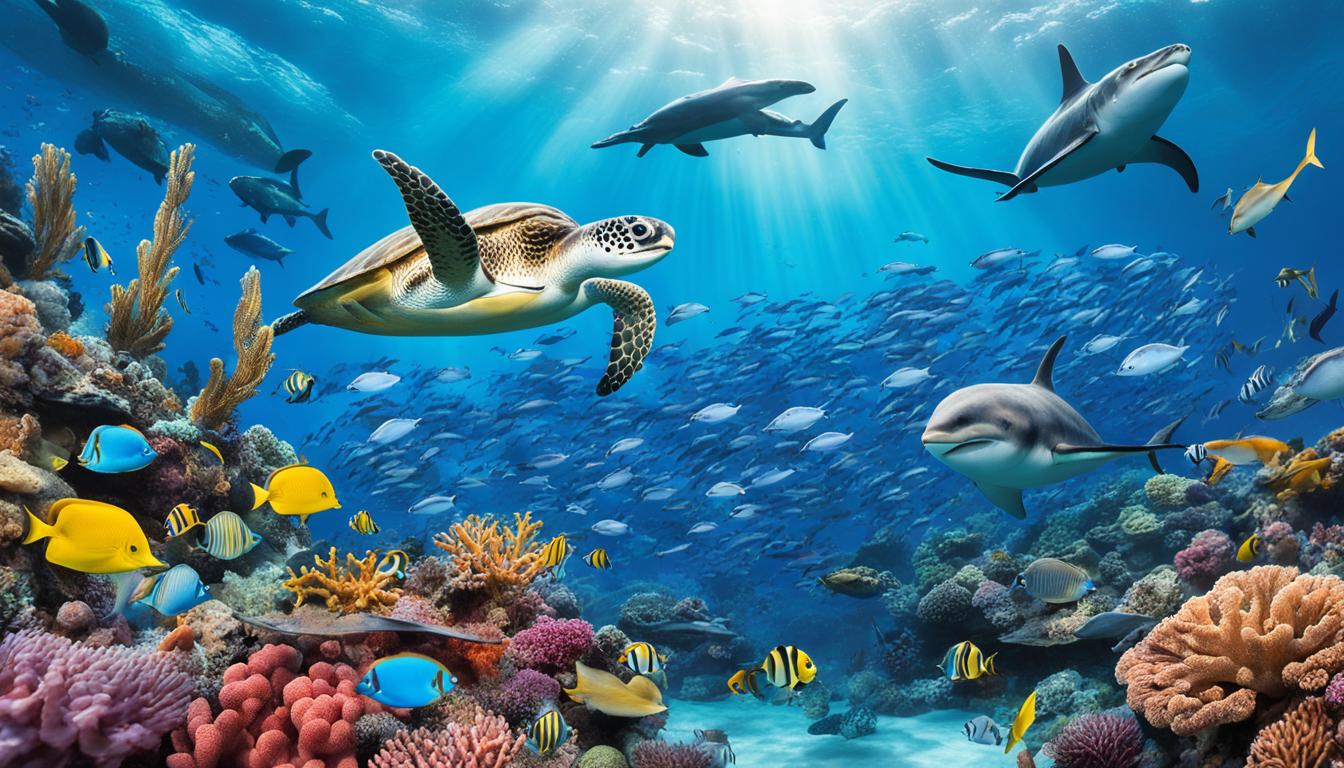
Freshwater Ecosystems: Lakes, Rivers, and Wetlands
Freshwater habitats, though covering a smaller fraction of Earth, are just as intricate. The fresh waters of the freshwater ecosystems, such as lakes and rivers, are vital for the survival of innumerable species, including humans.
These environments are more than just housing for creatures; they bestow upon us essential services like climate regulation and serve as fundamental resources for food and recreational activities.
The essence of ocean biodiversity cannot be overstated, as it is the lifeline of marine habitats and, by extension, our own survival.
- Lakes provide a relatively stable environment for aquatic plants, fish, and amphibians, acting as self-contained biomes.
- Rivers, constantly on the move, shape landscapes and support life both within their waters and along their banks. Salmon migrations are one of the many wonders tied to river systems.
- Wetlands, including marshes and swamps, are among the most productive ecosystems on Earth, essential for water purification and biodiversity.
| Ecosystem Type | Characteristics | Key Species |
|---|---|---|
| Marine | High salinity, includes oceans, reefs, and estuaries | Corals, Sea Turtles, Mangroves |
| Freshwater | Low salinity, includes lakes, rivers, and wetlands | Freshwater Fish, Amphibians, Waterfowl |
| Ecosystem Type | Biodiversity Contributions | Conservation Concerns |
|---|---|---|
| Freshwater | Habitats for species-rich communities, crucial for species like migratory salmon | Pollution, habitat fragmentation, invasive species |
| Marine | Climate regulation, vast food resources, and recreational spaces | Overfishing, ocean acidification, coral bleaching |
By understanding the delicate balance within different ecosystems, including the vast array of aquatic ecosystems like marine and freshwater ecosystems, we can begin to grasp the crucial role they play in the global ecological network. As you stand on the shore of a lake or the edge of the ocean, reflect on this intricate web of life and the need to protect these vital ecosystems for generations to come.
Terrestrial Ecosystems
When you picture the vibrant tapestry of the Earth’s terrestrial ecosystems, imagine the rolling expanses of grassland ecosystems and the stark beauty of the Arctic tundra.
These ecosystems are classified under an array of biomes, each a significant category within ecosystem classification.
Humans, flora, and fauna have forged intricate relationships within these ecosystems. Take, for instance, the plains where Native American tribes once thrived alongside the bison – an iconic species that played a central role in the region’s ecology and culture.
However, the escalating human footprint has led to transformative changes. Urban sprawl, agriculture, and industry are reshaping these natural communities, often to the detriment of biodiversity. But there’s still time to reverse this course through conscious efforts focused on sustainability and conservation, ensuring these ecosystems can be cherished for generations to come.
| Ecosystem Type | Key Vegetation | Dominant Wildlife | Unique Characteristics |
|---|---|---|---|
| Grasslands | Prairie grasses, wildflowers | Bison, prairie dogs, wolves | Wide open spaces, fertile soils |
| Forests | Conifers, broadleaf trees | Owls, bears, foxes | Layered canopies, diverse microclimates |
| Deserts | Cacti, shrubs | Reptiles, rodents | Extreme temperature shifts, low rainfall |
| Tundra | Mosses, lichens | Caribou, arctic hares | Permafrost, short growing seasons |
The preservation of these lands is not just about protecting beauty and biodiversity, but also about maintaining the health of the entire planet.
Forest Ecosystems and Their Subtypes
Forest ecosystems, critical to our planet’s health, fall into three primary categories:
- tropical,
- temperate, and
- boreal forests.
Tropical forests are biodiversity powerhouses, situated near the equator, and are responsible for a remarkable portion of the Earth’s oxygen production.
Temperate forests, with their distinct seasonal patterns, bolster nutrient cycles and stabilize climate.
The expansive boreal forests of the Northern Hemisphere are not only mesmerizing in their evergreen splendor but act as substantial carbon sinks, playing a key role in global carbon management.
Grasslands: A Vast Carbon Sink
Encompassing savannas and temperate grasslands, grassland ecosystems present a stark yet vibrant tableau of life. With deep, intricate root networks, these ecosystems are unparalleled in their ability to store carbon, mitigating climate change.
The oases of biodiversity within grasslands not only support an array of wildlife but are also fundamental to agricultural activities, nourishing human populations across continents.
Tundras: The Cold Desolation
In the Earth’s polar extremities and at the highest altitudes, tundra ecosystems hold secrets to climate patterns as indicator ecosystems.
- The arctic tundra, with its permafrost, is a frozen reservoir of carbon, while the
- alpine tundra is home to specialized flora and fauna that can survive the harsh, windswept, frigid conditions.
Both are stark indicators of climate change, affecting and reflecting alterations happening globally.
Deserts: Extreme Survival and Hidden Riches
Desert ecosystems, covering a staggering one-fifth of the Earth’s surface, are landscapes of extreme survival where life thrives against the odds. The spectrum of deserts
- arid deserts with vast dunes, semi-arid, and
- coastal deserts
each hold unique adaptations and biodiversities, making them crucial studies in resilience and ecosystem dynamics.
| Ecosystem Type | Characteristics | Global Significance | Annual Value Estimation |
|---|---|---|---|
| Forest Ecosystems | Diversity of flora and fauna, Climate mitigation through carbon sequestration | Critical oxygen production, Biodiversity support | $4.7 trillion |
| Grassland Ecosystems | Extensive root systems, Carbon storage, Agricultural importance | Biodiversity conservation, Soil restoration | $20.8 trillion |
| Tundra Ecosystems | Minimal vegetation, Permafrost carbon storage, Cold and harsh conditions | Indicator of global climate health, Climate mitigation | $261 billion |
| Desert Ecosystems | Specialized adaptations, Varying aridity levels, Mineral resources | Study of extreme survival, Resource provision | Less quantified |
In conclusion, it is vital to recognize the intricate balance between these terrestrial ecosystems: the lush forest canopies, the golden expanses of grasslands, the silent tundras, and the mysterious deserts.
Ecosystem Interconnectivity: A Global Perspective
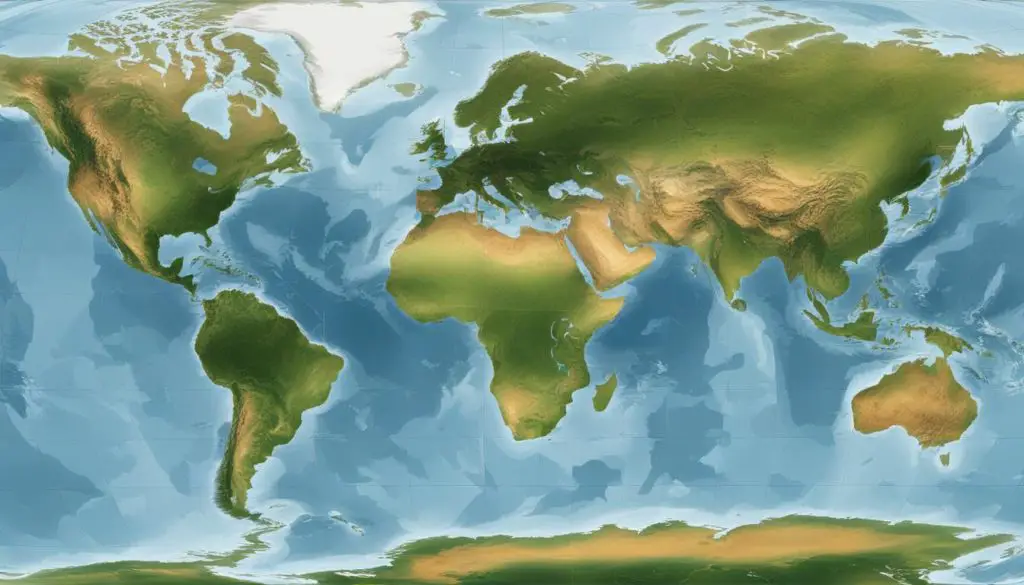
As you explore the natural world, you’ll begin to see the immense web of life that spans our planet. Ecosystem interconnectivity plays a pivotal role in the richness and variety of life we enjoy. Each ecosystem, a unique thread in the global ecological fabric, contributes to the overall health and vitality of our environment.
Disturbances such as biodiversity loss or climatic shifts in one area can result in ripple effects across various ecosystems, demonstrating the essential nature of a holistic approach to ecological conservation.
The Ripple Effect Across Ecosystems
The interaction of biotic and abiotic factors drives the complexities of interconnected ecosystems. When examining the impact of changes within one system, it is evident that no ecosystem functions in isolation. Rather, they contribute to a network of life-sustaining processes that traverse the planet’s various habitats.
Case Study: The Life Cycle of Salmon and Ecosystem Interdependence
In illustrating the concept of ecosystem interdependence, the salmon lifecycle emerges as a perfect example. Salmon, a species that migrates between freshwater and marine environments, exemplifies the deep connections between distinct ecosystem types.
| Salmon Life Stage | Role in Freshwater Ecosystems | Role in Marine Ecosystems | Impact on Terrestrial Ecosystems |
|---|---|---|---|
| Birth | Nutrient cycling in streams | – | – |
| Growth | – | Prey and predator dynamics | – |
| Maturity | Erosion control, channel shaping | Sequestering ocean nutrients | – |
| Spawning | Gene flow, species diversity | – | Food source for wildlife |
| End of Lifecycle | Decomposition enriches soil | – | Nutrient transfer to vegetation |
From their birth in freshwater streams to their oceanic journeys, salmon participate in a complex dance of ecosystem interdependence. As they travel, they carry with them critical nutrients that bolster not only the aquatic environments but also support adjacent terrestrial ecosystems.
Upon concluding their lifecycle, the body of a salmon becomes a concentrated source of nourishment, thus illustrating the intricate ways in which ecosystems are intertwined.
The Role of Biomes in Ecosystem Classification
From the frost-tipped peaks of alpine ranges to the sun-baked expanse of the Sahara, biomes represent the way scientists categorize types of ecosystems on a broad scale. Biomes are informed by climatic conditions and they, in turn, dictate the flora and fauna that can thrive within them. Ecosystem classification within these biomes offers a window into understanding how diverse life forms have adapted to their unique habitats and how they interact with each other.
How Ecosystems Influence Each Other
The idea of separation between ecosystems is, in many ways, a misconception. Global ecosystems are not isolated entities; rather, they are continuously affecting and being affected by one another. For instance, the deforestation in one region can lead to climate changes in another, illustrating the profound interdependencies that define our global ecology.
| Ecosystem Type | Characteristics | Global Interconnectivity Example |
|---|---|---|
| Forest Ecosystems | Diverse flora and fauna, high canopies, layered vegetation structures | Trees absorbing CO2, affecting global carbon levels |
| Desert Ecosystems | Low rainfall, extreme temperatures, specialized survival strategies | Sandstorms influencing weather patterns in distant regions |
| Tundra Ecosystems | Cold climate, limited vegetation, permafrost | Melting permafrost releasing greenhouse gases, impacting global temperatures |
In essence, as you learn more about these intricate links, you begin to see that the actions taken in one part of the world can have cascading effects on ecosystem interconnectivity on a global scale. Encouraging awareness and stewardship of our interconnected ecosystems is not just beneficial—it’s crucial for the future of our planet.
Diverse Habitats: Exploring Forest, Desert, and Grassland Ecosystems
When you imagine the world’s habitats, you’re conjuring images of the leaf-laden floor of forest ecosystems, the vast dunes of desert ecosystems, and the sea of grass in grassland ecosystems. These diverse habitats are integral to our planet’s health and complexity. Let’s embark on a virtual expedition to uncover the adaptive strategies that propel life in these contrasting environments.
Forest Ecosystems: More Than Just Trees
Envisage walking through a dense forest—the sunlight peeks through the canopy while the aroma of damp earth fills the air. It’s more than just a congregation of trees; it’s a living network where every plant, animal, and microbe depends on another for survival. **Forest ecosystems** provide oxygen, stabilize the climate, and are sanctuaries for an astounding array of wildlife. Despite their resilience, they face deforestation, threatening the wealth of biodiversity they support.
Desert Ecosystems: Life in Arid Landscapes
In stark contrast to the verdant forests, **desert ecosystems** offer a unique spectacle of life’s perseverance. Here, an array of species has evolved sophisticated adaptations to withstand the punishing heat and scarceness of water. From nocturnal lizards to cacti with sun-reflecting surfaces, deserts are not the lifeless sands they are often believed to be. Preserving these ecosystems is essential to maintaining the delicate balance of our planet’s diversity.
Grassland Ecosystems: The Savannas and Prairies
Amidst the realms of grass that wave in the wind lies the heart of **grassland ecosystems**—the savannas and prairies. These terrains are bustling with life, whether it’s the grazing herds of the African savanna or the fluttering insects of the North American prairies. Rich in species like the towering giraffes or burrowing prairie dogs, these ecosystems paint a vivid picture of the variety inherent in our world’s **diverse habitats**. Ongoing conservation efforts aim to protect these vibrant ecosystems from the detrimental effects of agricultural expansion and climate change.
As you delve into the intricate tapestry of Earth’s habitats, it’s evident that each ecosystem plays a crucial role in the global ecological ballet. Your understanding and appreciation of these habitats deepen respect for natural diversity and underscore the urgency for preserving these priceless global treasures.
The Impact of Human Activities on Different Ecosystems
The burgeoning footprint of human existence is unmissable across the planet’s varied ecosystems. Your actions, whether as simple as consuming products or as complex as altering landscapes, ripple through the environment in profound ways. The link between human impact on ecosystems and the resulting degradation is more apparent now than ever. Consumption patterns swell beyond the Earth’s carrying capacity, pollution chokes the once-thriving habitats, and climate change alters the very fabric of terrestrial and aquatic biomes.
Consumption, Pollution, and Climate Change
Consider the plastic bottle you use, the car you drive, or the energy that powers your home—all of these conveniences come at a cost to nature. Each demands raw materials and energy, leading to habitat destruction and increased greenhouse gases. And pollution, a byproduct of modern life, insidiously infiltrates ecosystems, from the deepest oceans to the highest mountains, causing harrowing consequences for biodiversity and ecological balance. As you witness extreme weather events and witness their aftermath, it becomes clear that climate change is no longer a distant threat but a present-day crisis, reshaping ecosystems at an alarming rate.
Conservation Efforts and The Rebound of Ecosystems
In response to these alarming trends, a surge of ecological conservation efforts has emerged, championing the resilience and recovery of ecosystems. Ecuador’s legal recognition of nature’s rights presents a pioneering move towards more sustainable practices. Monitoring efforts, such as those undertaken by Marine GEO, offer a beacon of hope by demonstrating that when given a chance, ecosystems can rebound from the brink of collapse. It’s in the coalescence of communal determination and scientific insight that your hope lies for a future where the symphony of Earth’s ecosystems thrives in harmony with human progression.

Planet Earth hosts an immense tapestry of life, a testament to ecosystem diversity that pervades every corner of the globe. From the lush depths of ancient rainforests to the enigmatic expanse of desert landscapes, our world comprises diverse ecosystem categories that sustain the complex web of life.
Diving into the myriad forms that nature takes can lead to pressing questions, such as “what are the types of biodiversity?” As we explore, we come to understand how each species and the singular genetic narrative it carries contributes significantly to an ecosystem’s resilience and productivity. We journey through the awe-inspiring variety of habitats that paint our planet’s ecological canvas.
One finds that every ecosystem is a universe in its own right. Rich with interconnected life forms and abiotic factors solidifying those connections, each ecosystem illustrates a unique chapter in Earth’s grand story of natural diversity. Let’s uncover the beautiful complexity of the ecosystems that nurture our existence.
The Imperative of Biodiversity in Sustaining Ecosystem Balance
The intricate tapestry of life on Earth, known as biodiversity, plays a pivotal role in maintaining the vitality and equilibrium of our planet’s ecosystems.
This diversity is not only a marvel to behold but also an essential contributor to the stability and resilience of the vast array of habitats and ecological systems we depend on.
From the smallest genetic variations to the broad spectrum of species and ecosystems, biodiversity is the foundation upon which the health of our natural world rests.
Understanding Biodiversity and Its Elements
The concept of biodiversity encompasses three fundamental levels:
- genetic diversity,
- species diversity, and
- ecosystem diversity.
Genetic diversity represents the range of genetic characteristics within each species, providing populations with the ability to adapt to changing environments.
Species diversity refers to the multitude of living organisms that inhabit the major ecosystems of the world.
Ecosystem diversity captures the variety of ecological systems, each with unique processes and interactions that sustain life.
The Consequences of Biodiversity Loss
Biodiversity loss is an alarming trend with far-reaching implications. With the extinction of each species and the degradation of natural habitats, we lose irreplaceable genetic material and weaken the very fabric of the ecosystems that support us. As a result, the critical services that biodiversity provides – such as water purification, pollination of crops, and the regulation of climate – are under threat, amplifying the urgent need to address the causes of biodiversity lossand protect our planet’s delicate ecological balance.
Drivers of Biodiversity Decline
The loss of biodiversity is driven by multiple, often intertwined causes. Prominent among them are drastic changes in land and sea use, which fragment and degrade the habitats that various species and ecological systems rely on.
The relentless exploitation of natural resources, accelerated by climate change, pollution, and the spread of invasive species, poses serious threats to ecosystems and their inhabitants. Understanding and mitigating these pressures is paramount to conserving the genetic diversity and richness of life that forms the backbone of our environment.
Types of Ecosystems

The variety and richness of life on Earth can be largely attributed to its diverse types of ecosystems. Ecosystems can be classified into two fundamental categories:
- terrestrial and
- aquatic.
Terrestrial ecosystems include habitats like forests and deserts, while aquatic ecosystems encompass both freshwater and marine environments.
Each type of ecosystem is characterized by unique physical factors – such as climate and soil type – that determine the kinds of life forms that can thrive within them.
Understanding the ecosystem classification and the examples within each category is crucial for recognizing the complexity of our planet’s biosphere. The following ecosystem types and examples provide a glimpse into the breadth of environments that support life:
- Forests: Expanses of tree coverage that range from the densely tree-packed rainforests near the equator to the coniferous forests of the colder, northern latitudes.
- Grasslands: Wide, open plains predominantly covered by grasses, often found between forest and desert ecosystems, which include the great savannas and prairies.
- Tundras: The coldest of all the ecosystems, largely devoid of trees, where the subsoil is permanently frozen and the vegetation is limited to low-growing shrubs and grasses.
- Deserts: Arid environments that receive very little rainfall and where specialized plants and animals have adapted to the harsh conditions.
- Freshwater Environments: Inland water bodies like rivers, lakes, and streams that house diverse species adapted to the water’s low salt concentration.
- Marine Ecosystems: Saltwater environments of the oceans, which include coral reefs, deep sea, and estuaries teeming with marine life.
Such diversity among ecosystems is indispensable to the stability and sustainability of our environment. The intricate interdependence within and between these ecosystems is a testament to the adaptability and resilience of living organisms. Below is a table categorizing the primary types of ecosystems and some of the unique characteristics that define them:
| Ecosystem Type | Defining Characteristics | Examples |
|---|---|---|
| Forest | Dense tree cover, rich biodiversity, crucial oxygen supply | Amazon Rainforest, Black Forest |
| Grassland | Grassy plains, fertile soils, significant carbon sink | Serengeti Plains, Great Plains |
| Tundra | Permafrost subsoil, low vegetation, cold-tolerant species | Arctic Tundra, Alpine Tundra |
| Desert | Low precipitation, extreme temperatures, adapted flora and fauna | Sahara Desert, Mojave Desert |
| Freshwater | Inland waters, diverse aquatic life, crucial for species’ life cycles | Mississippi River, Lake Baikal |
| Marine | Saltwater, high biodiversity, includes the deepest parts of the ocean | Great Barrier Reef, Marianas Trench |
By examining ecosystem types and their unique attributes, we gain insight into the remarkable adaptability and interconnectedness of life on Earth.
Terrestrial Ecosystems
Spanning the globe, terrestrial ecosystems encompass the vast expanses of biologically rich environments. From the lush foliage of the tropics to the stark beauty of deserts, these habitats are vital for biodiversity and human well-being. Here, we take a closer look at the complexity and importance of forest and grassland ecosystems, the stark tundra regions, and the surprising resilience of desert landscapes.
F
Forest Ecosystems and Their Subtypes
Forest ecosystems, critical to our planet’s health, fall into three primary categories:
- tropical,
- temperate, and
- boreal forests.
Tropical forests are biodiversity powerhouses, situated near the equator, and are responsible for a remarkable portion of the Earth’s oxygen production.
Temperate forests, with their distinct seasonal patterns, bolster nutrient cycles and stabilize climate.
The expansive boreal forests of the Northern Hemisphere are not only mesmerizing in their evergreen splendor but act as substantial carbon sinks, playing a key role in global carbon management.
Grasslands: A Vast Carbon Sink
Encompassing savannas and temperate grasslands, grassland ecosystems present a stark yet vibrant tableau of life. With deep, intricate root networks, these ecosystems are unparalleled in their ability to store carbon, mitigating climate change.
The oases of biodiversity within grasslands not only support an array of wildlife but are also fundamental to agricultural activities, nourishing human populations across continents.
Tundras: The Cold Desolation
In the Earth’s polar extremities and at the highest altitudes, tundra ecosystems hold secrets to climate patterns as indicator ecosystems.
- The arctic tundra, with its permafrost, is a frozen reservoir of carbon, while the
- alpine tundra is home to specialized flora and fauna that can survive the harsh, windswept, frigid conditions.
Both are stark indicators of climate change, affecting and reflecting alterations happening globally.
Deserts: Extreme Survival and Hidden Riches
Desert ecosystems, covering a staggering one-fifth of the Earth’s surface, are landscapes of extreme survival where life thrives against the odds. The spectrum of deserts
- arid deserts with vast dunes, semi-arid, and
- coastal deserts
each hold unique adaptations and biodiversities, making them crucial studies in resilience and ecosystem dynamics.
| Ecosystem Type | Characteristics | Global Significance | Annual Value Estimation |
|---|---|---|---|
| Forest Ecosystems | Diversity of flora and fauna, Climate mitigation through carbon sequestration | Critical oxygen production, Biodiversity support | $4.7 trillion |
| Grassland Ecosystems | Extensive root systems, Carbon storage, Agricultural importance | Biodiversity conservation, Soil restoration | $20.8 trillion |
| Tundra Ecosystems | Minimal vegetation, Permafrost carbon storage, Cold and harsh conditions | Indicator of global climate health, Climate mitigation | $261 billion |
| Desert Ecosystems | Specialized adaptations, Varying aridity levels, Mineral resources | Study of extreme survival, Resource provision | Less quantified |
In conclusion, it is vital to recognize the intricate balance between these terrestrial ecosystems: the lush forest canopies, the golden expanses of grasslands, the silent tundras, and the mysterious deserts.
orest Ecosystems and Their Subtypes
Forest ecosystems, critical to our planet’s health, fall into three primary categories:
- tropical,
- temperate, and
- boreal forests.
Tropical forests are biodiversity powerhouses, situated near the equator, and are responsible for a remarkable portion of the Earth’s oxygen production.
Temperate forests, with their distinct seasonal patterns, bolster nutrient cycles and stabilize climate.
The expansive boreal forests of the Northern Hemisphere are not only mesmerizing in their evergreen splendor but act as substantial carbon sinks, playing a key role in global carbon management.
Grasslands: A Vast Carbon Sink
Encompassing savannas and temperate grasslands, grassland ecosystems present a stark yet vibrant tableau of life. With deep, intricate root networks, these ecosystems are unparalleled in their ability to store carbon, mitigating climate change.
The oases of biodiversity within grasslands not only support an array of wildlife but are also fundamental to agricultural activities, nourishing human populations across continents.
Tundras: The Cold Desolation
In the Earth’s polar extremities and at the highest altitudes, tundra ecosystems hold secrets to climate patterns as indicator ecosystems.
- The arctic tundra, with its permafrost, is a frozen reservoir of carbon, while the
- alpine tundra is home to specialized flora and fauna that can survive the harsh, windswept, frigid conditions.
Both are stark indicators of climate change, affecting and reflecting alterations happening globally.
Deserts: Extreme Survival and Hidden Riches
Desert ecosystems, covering a staggering one-fifth of the Earth’s surface, are landscapes of extreme survival where life thrives against the odds. The spectrum of deserts
- arid deserts with vast dunes, semi-arid, and
- coastal deserts
each hold unique adaptations and biodiversities, making them crucial studies in resilience and ecosystem dynamics.
| Ecosystem Type | Characteristics | Global Significance | Annual Value Estimation |
|---|---|---|---|
| Forest Ecosystems | Diversity of flora and fauna, Climate mitigation through carbon sequestration | Critical oxygen production, Biodiversity support | $4.7 trillion |
| Grassland Ecosystems | Extensive root systems, Carbon storage, Agricultural importance | Biodiversity conservation, Soil restoration | $20.8 trillion |
| Tundra Ecosystems | Minimal vegetation, Permafrost carbon storage, Cold and harsh conditions | Indicator of global climate health, Climate mitigation | $261 billion |
| Desert Ecosystems | Specialized adaptations, Varying aridity levels, Mineral resources | Study of extreme survival, Resource provision | Less quantified |
In conclusion, it is vital to recognize the intricate balance between these terrestrial ecosystems: the lush forest canopies, the golden expanses of grasslands, the silent tundras, and the mysterious deserts.
Exploring the Depths of Aquatic Ecosystems
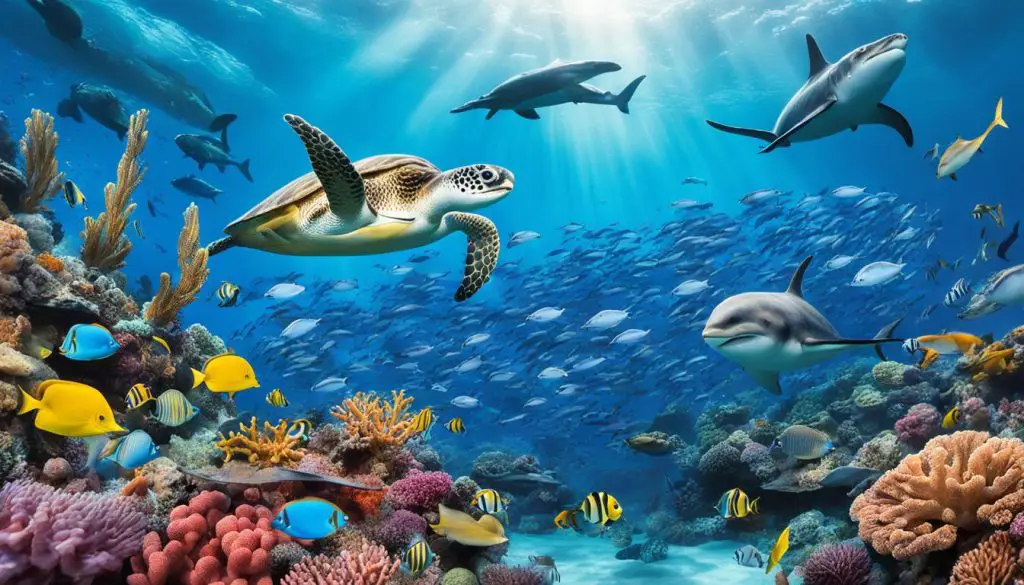
Diving into the world of aquatic ecosystems opens up a realm teeming with life and intricate ecological interactions. Not only do these water-enveloped environments constitute a substantial portion of the Earth’s biosphere, but they also present an endless opportunity for exploration and discovery.
The significance of aquatic habitats extends beyond mere existence; they are foundational to sustaining a myriad of species and are central to the very essence of ocean biodiversity.
Freshwater Ecosystems: Sources of Biodiversity
Within the spectrum of aquatic ecosystems, freshwater ecosystems, such as rivers, lakes, and wetlands, stand as critical reservoirs of biodiversity.
These water bodies shape the lives of countless species, dictating their ecological narratives from birth to maturity.
Salmon, for instance, rely on the pristine conditions of freshwater streams for spawning, hinting at the broader picture of life cycles deeply woven into these habitats. Protecting these ecosystems is paramount to preserving the diversity that enriches our natural world and ensures the balance needed for all species to prosper.
Marine Ecosystems: The Oceans’ Bountiful Life
The marine ecosystems hold the majority of life on our planet, boasting unparalleled levels of diversity. From the shallow sunlit coral reefs bustling with colorful marine life to the mysterious and scarcely explored trenches in the depths of the oceans, the range of habitats is as diverse as the life they host.
These environments are more than just housing for creatures; they bestow upon us essential services like climate regulation and serve as fundamental resources for food and recreational activities.
The essence of ocean biodiversity cannot be overstated, as it is the lifeline of marine habitats and, by extension, our own survival.
| Ecosystem Type | Biodiversity Contributions | Conservation Concerns |
|---|---|---|
| Freshwater | Habitats for species-rich communities, crucial for species like migratory salmon | Pollution, habitat fragmentation, invasive species |
| Marine | Climate regulation, vast food resources, and recreational spaces | Overfishing, ocean acidification, coral bleaching |
As we navigate through the intricacies of aquatic ecosystems, from the charming freshwater to the expansive marine habitats, the onus falls on us to ensure these environments are sustained for future generations.
Different Ecosystem Types
Ecosystem interconnectivity plays a pivotal role in maintaining the delicate balance within the natural world. Disturbances such as biodiversity loss or climatic shifts in one area can result in ripple effects across various ecosystems, demonstrating the essential nature of a holistic approach to ecological conservation.
The Ripple Effect Across Ecosystems
The Ripple Effect Across Ecosystems
The interaction of biotic and abiotic factors drives the complexities of interconnected ecosystems. When examining the impact of changes within one system, it is evident that no ecosystem functions in isolation. Rather, they contribute to a network of life-sustaining processes that traverse the planet’s various habitats.
Case Study: The Life Cycle of Salmon and Ecosystem Interdependence
In illustrating the concept of ecosystem interdependence, the salmon lifecycle emerges as a perfect example. Salmon, a species that migrates between freshwater and marine environments, exemplifies the deep connections between distinct ecosystem types.
| Salmon Life Stage | Role in Freshwater Ecosystems | Role in Marine Ecosystems | Impact on Terrestrial Ecosystems |
|---|---|---|---|
| Birth | Nutrient cycling in streams | – | – |
| Growth | – | Prey and predator dynamics | – |
| Maturity | Erosion control, channel shaping | Sequestering ocean nutrients | – |
| Spawning | Gene flow, species diversity | – | Food source for wildlife |
| End of Lifecycle | Decomposition enriches soil | – | Nutrient transfer to vegetation |
From their birth in freshwater streams to their oceanic journeys, salmon participate in a complex dance of ecosystem interdependence. As they travel, they carry with them critical nutrients that bolster not only the aquatic environments but also support adjacent terrestrial ecosystems.
Upon concluding their lifecycle, the body of a salmon becomes a concentrated source of nourishment, thus illustrating the intricate ways in which ecosystems are intertwined.
The interaction of biotic and abiotic factors drives the complexities of interconnected ecosystems. When examining the impact of changes within one system, it is evident that no ecosystem functions in isolation. Rather, they contribute to a network of life-sustaining processes that traverse the planet’s various habitats.
Case Study: The Life Cycle of Salmon and Ecosystem Interdependence
In illustrating the concept of ecosystem interdependence, the salmon lifecycle emerges as a perfect example. Salmon, a species that migrates between freshwater and marine environments, exemplifies the deep connections between distinct ecosystem types.
| Salmon Life Stage | Role in Freshwater Ecosystems | Role in Marine Ecosystems | Impact on Terrestrial Ecosystems |
|---|---|---|---|
| Birth | Nutrient cycling in streams | – | – |
| Growth | – | Prey and predator dynamics | – |
| Maturity | Erosion control, channel shaping | Sequestering ocean nutrients | – |
| Spawning | Gene flow, species diversity | – | Food source for wildlife |
| End of Lifecycle | Decomposition enriches soil | – | Nutrient transfer to vegetation |
From their birth in freshwater streams to their oceanic journeys, salmon participate in a complex dance of ecosystem interdependence. As they travel, they carry with them critical nutrients that bolster not only the aquatic environments but also support adjacent terrestrial ecosystems.
Upon concluding their lifecycle, the body of a salmon becomes a concentrated source of nourishment, thus illustrating the intricate ways in which ecosystems are intertwined.
Preserving Our Natural Heritage: The Need for Ecological Conservation
In the face of mounting environmental challenges, our world requires a dedicated and coherent approach towards ecological conservation.
Prioritizing the protection of entire habitats and ecosystems is not just a nod to the fabric of life they support but is an acknowledgement of their fundamental role in sustaining biodiversity.
With the implementation of comprehensive conservation strategies, there is a clarion call to protect the boundless variety of life that makes our planet unique, functional, and resilient.
Conservation Strategies and Their Importance
Embracing broad-scale ecological conservation approaches makes it possible to combat the diverse threats of habitat destruction, pollution, and climate change. The importance of crafting and executing effective conservation strategiescannot be overstated. These strategies form the cornerstone of eco-centric policymaking, guiding us in the stewardship of the natural world. Collaborative efforts to counteract destructive behaviors are essential in preserving the ecological heritage that is the birthright of every species, including our own.
Megadiverse Countries and Conservation Responsibility
The concept of megadiverse countries, such as Australia, comes with the recognition of a greater responsibility towards the preservation of Gondwanan diversity and endemic species. These nations, rich in unique ecosystems, are custodians of the world’s biodiversity. They play a pivotal role in shielding invaluable and irreplaceable ecosystems, ranging from coral reefs to ancient rainforests, ensuring that their national policies reflect the gravity of this duty.
Global Initiatives and Policies Aiming at Biodiversity Preservation
At the heart of global sustainability and ecological integrity are global initiatives like the Convention on Biological Diversity, which, alongside other organizations, constructs an intricate network aiming at large-scale biodiversity preservation. International agreements and ecosystem policies are the frameworks within which local governance and community action can find direction and support, securing a living, thriving planet for present and future generations.
FAQ
Q: What Are the Different Types of Ecosystems?
A: Ecosystems can broadly be classified into two main categories: terrestrial and aquatic. Terrestrial ecosystems include forests, grasslands, deserts, and tundras, each hosting a unique array of flora and fauna adapted to their specific environments. Aquatic ecosystems are categorized as freshwater or marine, such as rivers, lakes, and oceans, which support rich biological communities.
Q: What is Biodiversity and Why is it Important?
A: Biodiversity refers to the variety of life on Earth at all levels, from genes to species to ecosystems. It includes the genetic diversity within species, the diversity of species themselves, and the range of ecosystems they create. Biodiversity is crucial because it contributes to ecosystem resilience, provides valuable ecosystem services, and is integral to the planet’s overall health.
Q: How Does Biodiversity Loss Affect Ecosystem Balance?
A: Biodiversity loss can lead to weakened ecosystems, fewer ecosystem services, and increased vulnerability to changes such as climate events. It disrupts the intricate balance of nature, jeopardizing food webs, nutrient cycles, and the ability of ecosystems to respond to environmental changes, which can have cascading effects on human well-being.
Q: What are the Major Causes of Biodiversity Decline?
A: The five principal drivers of biodiversity decline are changes in land and sea use, direct exploitation of organisms, climate change, pollution, and invasion of alien species. These factors result in habitat loss, reduced species populations, and genetic diversity, altering ecosystems globally.
Q: What Ecosystem Services Do Forests Provide?
A: Forest ecosystems offer a range of services including climate regulation, water purification, soil stabilization, carbon sequestration, and provide habitats for a vast number of species. They also support the livelihoods of many communities and have vast cultural and recreational importance.
Q: What Role Do Grasslands Play in the Environment?
A: Grasslands are critical for carbon storage, supporting biodiversity, and maintaining soil health. They host diverse plant and animal species, which are crucial for ecological processes such as pollination and seed dispersal, and are also vital for human agriculture and livelihoods.
Q: What Unique Characteristics Define Tundra Ecosystems?
A: Tundra ecosystems are characterized by extreme cold, long winters, short growing seasons, and minimal vegetation. Despite these challenging conditions, tundras host specially adapted fauna and flora and play an essential role in carbon storage within the permafrost, which is significant for climate regulation.
Q: How Do Deserts Contribute to Ecosystem Services?
A: Deserts provide unique habitats for a variety of specialized species that have adapted to the harsh conditions. They also house significant mineral and metal resources and play a role in climate regulation. Deserts illustrate the resilience of life and the value of biodiversity in extreme environments.
Q: What is the Importance of Freshwater Ecosystems?
A: Freshwater ecosystems are critical sources of biodiversity, maintaining species-rich habitats and supporting intricate food webs. They are key to the life cycle of various organisms, provide drinking water, enable agriculture through irrigation, and offer recreational spaces for human enjoyment.
Q: Why are Marine Ecosystems Vital for Biodiversity?
A: Marine ecosystems are home to a majority of Earth’s life forms, including numerous plant, animal, and microbe species. They are vital for climate regulation, oxygen production, and as a source of food, medicine, and raw materials. Maintaining their health is crucial for preserving global biodiversity.
Q: What is Ecosystem Interconnectivity?
A: Ecosystem interconnectivity refers to the myriad ways in which different ecosystems are linked through the exchange of energy, nutrients, water, and organisms. The health of one ecosystem often affects others, illustrating the importance of considering the ripple effects of environmental changes on a global scale.
Q: How Can We Conserve Ecosystems and Protect Biodiversity?
A: Conserving ecosystems and protecting biodiversity requires holistic strategies focusing on habitat protection, regulating and managing resource use, combating pollution, controlling invasive species, and mitigating climate change. This can involve policy reforms, international cooperation, and community engagement to ensure a sustainable future for our planet’s diverse ecological systems.
Q: What Role Do Megadiverse Countries Play in Conservation?
A: Megadiverse countries, with their high levels of species richness and endemism, have a heightened responsibility for conservation. They are custodians of a disproportionate amount of the world’s biodiversity and play a pivotal role in the global effort to protect and preserve unique ecosystems and species.
Q: Are There International Efforts to Address Biodiversity Preservation?
A: Yes, numerous international efforts and policies, such as the Convention on Biological Diversity, aim at preserving biodiversity. Organizations and governments worldwide are working on strategies to protect habitats, mitigate climate impact, and enhance sustainability practices to combat the biodiversity crisis.
Source Links
- https://spice-spotlight.scot/2022/10/03/natures-variety-biodiversity-explained/
- https://neprimateconservancy.org/biodiversity-ecosystem-diversity/
- https://australian.museum/learn/science/biodiversity/what-is-biodiversity/
- Which Water Source May Become Polluted as It Travels Over Land?
- What is the difference between Weather and Climate?
FAQ
Q: What are the different types of ecosystems?
A: Ecosystems are diverse and can be broadly classified into two categories: terrestrial and aquatic. Terrestrial ecosystems include forests, deserts, grasslands, and tundra, among others. Aquatic ecosystems are divided into marine ecosystems, like oceans, reefs, and estuaries, and freshwater ecosystems, such as lakes, rivers, and wetlands.
Q: What is biodiversity and why is it important?
A: Biodiversity refers to the variety of life in all its forms, from the genetic level to species and ecosystem levels. It’s essential because it ensures the stability and resilience of ecosystems, provides a source of food, medicine, and raw materials, supports recreational activities, and contributes to the overall health of our planet.
Q: How are new species discovered and why is this significant?
A: New species are often discovered through field expeditions, taxonomic analyses, and technological advancements enabling the study of previously inaccessible habitats. Species discovery is significant because it adds to our knowledge of biodiversity and helps us understand the complex interactions within ecosystems, which is crucial for conservation efforts.
Q: What are hotspots of biodiversity and where can they be found?
A: Hotspots of biodiversity are regions that have high levels of endemic species—those found nowhere else on Earth—and are under significant threat of habitat loss. Examples include the Amazon rainforest, Madagascar, and the coral triangle in the Indo-Pacific region. Protecting these hotspots is critical to preserving the planet’s biodiversity.
Q: How do marine and freshwater ecosystems differ?
A: Marine and freshwater ecosystems differ primarily in their salinity levels, with marine ecosystems containing high levels of salt and freshwater systems having relatively low salt content. This difference influences the types of species found in each ecosystem, as well as their physiological adaptations to their environments.
Q: What are the main categories of terrestrial ecosystems, and how do they differ?
A: The main categories of terrestrial ecosystems are forest ecosystems, grassland ecosystems, desert ecosystems, and tundra ecosystems. They differ in their climate, types of vegetation, and the animal species that inhabit them. For example, forests are characterized by dense tree cover, while grasslands are dominated by grasses, and deserts have sparse vegetation adapted to arid conditions.
Q: How does ecosystem interconnectivity affect global biodiversity?
A: Ecosystem interconnectivity influences global biodiversity by promoting the movement and exchange of species, genetic material, and nutrients between different ecosystems. This interconnectivity can enhance the resilience and adaptive capacity of ecosystems to environmental changes and maintain a balance within the global ecosystem.
Q: What human activities impact ecosystems and how?
A: Human activities such as deforestation, overfishing, pollution, and the emission of greenhouse gases impact ecosystems by altering habitats, reducing biodiversity, and disrupting the natural processes that sustain ecosystems. These activities can lead to habitat degradation, species extinction, and climate change, ultimately threatening the long-term health of our planet.
Q: How are conservation efforts helping to restore ecosystems?
A: Conservation efforts aim to protect and restore ecosystems through the establishment of protected areas, habitat restoration projects, sustainable resource management, and the enforcement of environmental laws. These efforts can help ecosystems rebound by giving them the time and space to recover and by supporting the conservation of threatened species and their habitats.
Source Links
- https://www.nationalgeographic.org/encyclopedia/biodiversity/
- https://www.nationalgeographic.org/encyclopedia/ecosystem/
- https://naturalhistory.si.edu/education/teaching-resources/life-science/what-biodiversity
- https://spice-spotlight.scot/2022/10/03/natures-variety-biodiversity-explained/
- https://neprimateconservancy.org/biodiversity-ecosystem-diversity/
- https://australian.museum/learn/science/biodiversity/what-is-biodiversity/
- Which Water Source May Become Polluted as It Travels Over Land?
- What is the difference between Weather and Climate?





